Club History
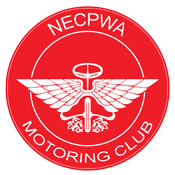 NECPWA History. Based on a monthly series of accounts originally compiled in 2016 of the founding and development of NECPWA By Janek Grajewski, Club Librarian & Archivist with a few later minor updates to reflect the current situation.
NECPWA History. Based on a monthly series of accounts originally compiled in 2016 of the founding and development of NECPWA By Janek Grajewski, Club Librarian & Archivist with a few later minor updates to reflect the current situation.
THE FOUNDING OF THE CAR CLUB KNOWN AS NECPWA
The year was 1966. A school teacher of English from Newcastle, his name, our founder Mr. Tony Pelton, (who is sadly no longer with us) who once ran an antique bookshop in Catterick, though he did not have a driving licence or own a car himself, had noticed a lot of cars on the road were Austins. They were plentiful and cheap, and Tony thought that as some of these cars were now getting older, it would be a good idea to start up a car club for Austin cars, and he has been an Austin fan ever since.
The Start
Tony had decided in February 1966 to form a car club. Anyone he saw driving a 1930s, or later, Austin would be stopped, and a membership form thrust into his hand. (Try doing that now). Rumours were circulating about a chap from Newcastle who was chasing round, encouraging owners of pre-war Austins to join his new club. This caused consternation among the “old school”, dyed-in-the-wool vintage and veteran enthusiasts, who did not want this “1930s tinware” turning up at rallies and parking alongside their Alvises, Bullnose Morrises and Lagondas.
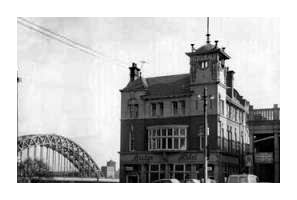 In May 1966, Tony wrote a news item to the Newcastle Evening Chronicle listing the registration numbers of pre-war Austin cars he had seen on the roads, inviting them to join him at the Bridge Hotel, Newcastle. Two drivers turned up. Tony informed the Evening Chronicle, and regular meetings were held.
A Mr. Charles Davey wrote to Tony enquiring about this new club and received a reply on 16th May 1966. Tony advised Mr. Davey: “The increasing interest (Northumberland, Durham and North Yorks) in the club now requires a fund to firmly establish the club and develop it. 10/- (50p) per member would probably cover the costs for the forthcoming months”. He advised that the next meeting would be 15th June at the Cradle Well Hotel, Jesmond, Newcastle, 7.30pm in the bar. At this point the new club did not even have a name!
Early members included Charles Davey, Stewart Skilbeck, Bill Tonks, Mike and Roger Potts, who gave the new club its name: The North East Club for Pre-War Austins.
In May 1966, Tony wrote a news item to the Newcastle Evening Chronicle listing the registration numbers of pre-war Austin cars he had seen on the roads, inviting them to join him at the Bridge Hotel, Newcastle. Two drivers turned up. Tony informed the Evening Chronicle, and regular meetings were held.
A Mr. Charles Davey wrote to Tony enquiring about this new club and received a reply on 16th May 1966. Tony advised Mr. Davey: “The increasing interest (Northumberland, Durham and North Yorks) in the club now requires a fund to firmly establish the club and develop it. 10/- (50p) per member would probably cover the costs for the forthcoming months”. He advised that the next meeting would be 15th June at the Cradle Well Hotel, Jesmond, Newcastle, 7.30pm in the bar. At this point the new club did not even have a name!
Early members included Charles Davey, Stewart Skilbeck, Bill Tonks, Mike and Roger Potts, who gave the new club its name: The North East Club for Pre-War Austins.
Club Rules and RAC Affiliation.
Tony soon realised the need to make the club more official, and bought into RAC affiliation. This enabled the club to use their standard set of rules for a car club. These rules, though much amended over the years to take into account changes within the club, are still the basis of our club rules today, and Rule 2, which still applies today, states object: The purpose of the club shall be to encourage the restoration and regular use of Historic Vehicles. The RAC offered help and advice to new clubs affiliated with motoring, as well as a discount for using their road side signage, which was used at Sledmere Rallies for many years.
Newsletter
In these fledgling times, Tony started a newsletter, initially on an ad hoc basis. This would include his design of our club logo, his own hand-drawn sketches, details of forthcoming events, general information, quips and adverts. These were all handwritten and drawn and then duplicated on a Roneo machine (younger members Google it!), in order to keep members in contact: the year was 1967 and the member numbers had grown to 10. Stewart Skilbeck was working in Durham as an articled clerk for a firm of accountants on 3 guineas a week (£3.15 in new money), and they had just bought a new-fangled photocopier. The club charged Stewart with sneaking in and using the photocopier, when the partners were at lunch, to produce a more professional newsletter. He reckoned that, as he was on only 3 guineas a week, they owed it to him! As the club membership grew and the Newsletter became larger, other members took on the job of editing, among them, Tony Simons, Keith Dobinson, Ian Findlay and Ray Price. When club funds allowed, it was upgraded to the professionally printed glossy we have today.
Vintage Advertiser
The need arose for a separate sheet, initially called “Mart and Seek” for advertisements. The first edition of the “Vintage Advertiser” became necessary in 1977. Tony’s reasons for its existence were; a) There was no cheap and easy way of passing on news and information about Vintage and Classic spares, and cars for sale and wanted, to enthusiasts in the North of England. b) Enthusiasts come across spares of all sorts, tyres, etc., and will find this publication a very useful way of passing information on. The first issue contained 65 adverts. Adverts were free of charge and clubs were invited to buy copies for 40p for 12 monthly issues. In September 1977, Tony press-ganged Jane Bee to take on the job of Vintage Advertiser Editor. She was in that post until 1990, when Ian Findlay’s wife, Gillian, took over on a temporary basis. Gillian in turn was succeeded by John Ashbridge in 1991. In May 2012, John decided to resign from the post. Advert numbers had been dwindling over a period of time, so the Executive Committee decided to incorporate Vintage Advertiser contents into the Newsletter.
Consolidation, regular meetings, subs & newsletter ads.
The first meeting was held at the Cradle Well and later in 1967, The Pot and Glass, Neville’s Cross, Durham. Tony had been talked into the move by new member, Stewart Skilbeck, as it was near his home and as money was tight, Stewart normally used the bus, and he had the (secret) use of a photocopier - photocopies were very expensive in those days. Tony, by then the owner of a scruffy 1934 Austin 12 van, in the summer months, for some reason would turn up with a big bag of tomatoes from his mother’s greenhouse and much beer was drunk in those pre-breathalyser days. The Pot and Glass was well attended, with fewer than 30 members being regarded as low. In 1967 minor arrangements were made, cars and parts being bought and sold, as was information. Other car owners heard of this and would turn up to sell cars - on one occasion, two owners arrived to sell their Austins, but after Tony had finished with them, they decided to keep their cars and join the club!
Other car clubs, like the 30/40 Motor Club of Newcastle, which also met at the Cradle Well, continued to snub the fledgling Austin club, as they preferred Rileys, MGs and Lagondas, though many of them later joined this little Austin club.
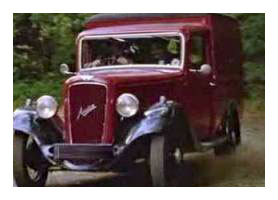 Tony continued to flag down any Austin he saw on the road and by now had enlisted the help of Stewart Skilbeck. Brave or stupid?
It was now 1967, the club was healthy with £7/19s/4d in the kitty (about £7.97). Tony recognised the growing popularity of the new club; membership was now 51 and the activities of NECPWA became known abroad.
Tony continued to flag down any Austin he saw on the road and by now had enlisted the help of Stewart Skilbeck. Brave or stupid?
It was now 1967, the club was healthy with £7/19s/4d in the kitty (about £7.97). Tony recognised the growing popularity of the new club; membership was now 51 and the activities of NECPWA became known abroad.
At the request of Neilson Skilbeck, who had asked to join the club with his Wolseley Siddley, it was decided to make the Austin club a multi-make car club, and motorbike enthusiasts also joined, like Bob Atkinson with his 1920 Excelsior, 1921 Triumph SD, 1926 BSA and 1927 Royal Enfield. Tony’s sights were now set even higher and organised the club's first display of cars at Seaton Sluice. It rained so much, only two cars turned up! Better luck at the Wolsingham Show in September: early entrants were the Potts brothers in their Austin 7, Stewart Skilbeck, who was now the owner of a 1927 Austin 7, which he was restoring, Charles Davey in his Austin Light 12, Steve Lobley with a vintage Austin 12, Bill Tonks an A30 van, Peter and Margaret Fox an Austin Sheerline and the gorgeous Judith Blandy, much admired by the men present. The little Austin club was now venturing further south, and at a steam rally in Stillington, York, met Tony and Val Edwards from Weldrake with their beautiful Austin Ruby. Tony Edwards was a real enthusiast and a “doer” and was soon roped in by Tony as secretary of a Yorkshire “section”. Regular meeting were held at The Pot and Glass and then at The Dawnay Arms, Shipton-by-Benningbrough by the new ‘section’. Tony had established the Mart and Seek, but by June 1968 with membership at 120 Tony recognised the need for something even more formal, hence the introduction of the Vintage Advertiser.
In 1972, Doug Bee, Alan Bee and Miss Jane Hodgson, later to become Mrs. Bee joined the club. Finally, in September 1977, after much cajoling, bribing and begging, the wily Tony Pelton talked Jane into producing the Vintage Advertiser, a role she undertook for many years. Tony, not merely content with his role as club secretary, saw himself as the custodian of Austins and would scour newspapers and scrapyards with the intention of saving cars to either put back on the road or as spares, and encouraged others to do the same. These were often listed in the newsletter as “Austins We Have Found”, and this was what later would become the “Spares Stores”. By 1971 membership had risen to 270 and was steadily increasing year-on-year. NECPWA was now firmly established with a monthly newsletter and separate Vintage Advertiser, collated and posted then by Stuart and Eileen McDonald, Eric and Anne Dobinson and the team. At this time, Tony Pelton was Secretary, Brian Nesbitt was Assistant Secretary, who took over from May Jones, and Peter Butler was Spares Secretary.
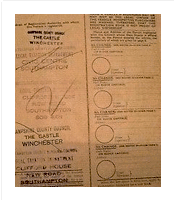 Many topics were printed in the newsletter including forthcoming outings, rallies, autojumbles, (the word coined by the late Lord Montague of Beaulieu), observations and general chit-chat. For example, in 1976 Ron Allison wrote an article on how to recover your old log book from the DVLA before they were destroyed. And who can forget Professor Arnold Sprocket and Dr. Engus Pod, penned by….(I know, dear reader; do you?)…. And this theme continued with Rip Racey and today with Norm D. Plume.
During the early days, Tony started the club Library and Museum. The Museum items were sold, as it was feared the glass petrol pump globes would get broken when they were moved to the club stores from being displayed at the David Royle premises.
The library, originally held by Tony Pelton, later by Tony Hazel, Ian Findlay and presently by your scribe is still a service offered to all members; the list of available resources is on the website, here: - Click Here -
Many topics were printed in the newsletter including forthcoming outings, rallies, autojumbles, (the word coined by the late Lord Montague of Beaulieu), observations and general chit-chat. For example, in 1976 Ron Allison wrote an article on how to recover your old log book from the DVLA before they were destroyed. And who can forget Professor Arnold Sprocket and Dr. Engus Pod, penned by….(I know, dear reader; do you?)…. And this theme continued with Rip Racey and today with Norm D. Plume.
During the early days, Tony started the club Library and Museum. The Museum items were sold, as it was feared the glass petrol pump globes would get broken when they were moved to the club stores from being displayed at the David Royle premises.
The library, originally held by Tony Pelton, later by Tony Hazel, Ian Findlay and presently by your scribe is still a service offered to all members; the list of available resources is on the website, here: - Click Here -
Branches & Executive Meetings
York Branch Following the setting up of a fledgling Yorkshire Section by Tony Edwards, Tony Pelton decided it was time to have a proper York Branch, as membership was growing in that area. Therefore, on 7th October 1967, Tony and Charles Davey went down to York with the intention of helping set up a York Branch. They were met by Tony Edwards, later to become branch secretary, Peter Butler, Trevor Miller, John Denton S & E Littlewood , John and Richard Dalby and a Mr. Burbage. They met at the Dawnay Arms, Shipton by Beningbrough, later to the Gimcrack, York, The Hop Grove, The Swarsman Inn, Stamford Bridge, The Windmill, Hull Road, and two years ago it was decided to have a bit of a roving monthly meet in order to not have the same members always travelling a long distance. Other branches started to develop, namely, Teeside, Bishop Auckland, started in 1976 at Bassinton, Carlisle, sadly ceased as a branch on 25th February 2007. Northallerton was set up by Tony when he moved to live in Catterick, where he still resides; Newcastle became Tyneside, the Spares Store is also classed as a branch. In the 1980s, some of the members in West Yorkshire suggested they set up a West Yorkshire Branch, but there was not enough interest at the time. We currently have six local branches, namely, Bishop Auckland, Cleveland, Durham, North Yorks, Tyneside (which includes Northumberland) and finally York who arrange their own branch meetings, road runs and rallies details of which are published in the Club Magazine.
Executive Meetings
As the club membership grew, Ian Findlay, secretary and newsletter editor, decided it was time to make the meetings more professional and in May 1984 suggested an Executive Committee. His proposals were agreed at the June AGM. The committee comprised Chairman, at that time Geo. Gardiner, Secretary, as Ian had felt his job done, stood down and the post was taken by Nigel Holmes, Treasurer was Gordon Tilseley. Each branch would elect at their AGMs two representatives with one vote each. Other officers and members were free to attend but could not vote, though they were at liberty to have their say, and such discussions would be taken into account when representatives voted. It was the job of each branch rep. To report back to the branch. Each official served a two-year term, with half the committee being up for re-election, should they wish, on alternate years, thereby safeguarding the smooth continuation of the club. This has proved very effective, so much so that the original four meetings per year has been reduced to two in February and October.
Sledmere House
Sledmere house was built in 1780, designed by Samuel Watt and Sir Christopher Sykes, 2nd Baronet. Originally a Georgian house, it was largely redesigned in 1790 in the Edwardian style. In 1911, it was almost destroyed by fire, though much of its contents were saved, furniture by Chippendale, Hepplewhite and Sheraton. The ornate plasterwork was carried out by Joseph Rose. The Gardens, designed by the capable, Lancelot Brown is still being developed, with the recent addition of “The Ascending Lark”, filled with 12000 bulbs which is part of the formal Potage. Today there is a children’s play area, Walled Rose Garden and Kitchen Garden with period greenhouse. Owned by Sir Tatton Sykes, it is famous for the Sledmere Stud. Today it is open to the public, with various events throughout the year, the largest of which is York Branch rally weekend, which now has the addition of a Nostalgia weekend.
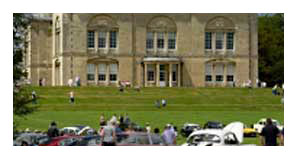 In 1975 Harry and Margaret Johnson, together with David and Sue Chalcroft approached Mrs Lambert, the house manager, with a view to holding a rally there.
The idea was to have a rally for enthusiasts, and this is still the case. However, the house saw an ideal opportunity to increase the numbers of visiting public, which has proved very popular, with the highest revenue taken on the Sunday.
The first rally was attended by 50 vehicles, an informal gathering, the organisers donating £50 each to cover costs. The rally became an annual event, always held on the last Sunday of June, and took a more formal identity as John Dalby and Lookers Garage had donated trophies. These trophies were increased; some donated, some bought to cover more and more marques attending, currently around 23 classes.
Mrs Anne Hines took over the running of the house when Mrs Lambert retired in 1989 and was very enthusiastic in promoting the rally, which had now grown to 250 vehicles including cars, bicycles, scooters, micro cars, motorbikes and light commercials. (The rally has now been discontinued by York Branch for financial reasons).
In 1975 Harry and Margaret Johnson, together with David and Sue Chalcroft approached Mrs Lambert, the house manager, with a view to holding a rally there.
The idea was to have a rally for enthusiasts, and this is still the case. However, the house saw an ideal opportunity to increase the numbers of visiting public, which has proved very popular, with the highest revenue taken on the Sunday.
The first rally was attended by 50 vehicles, an informal gathering, the organisers donating £50 each to cover costs. The rally became an annual event, always held on the last Sunday of June, and took a more formal identity as John Dalby and Lookers Garage had donated trophies. These trophies were increased; some donated, some bought to cover more and more marques attending, currently around 23 classes.
Mrs Anne Hines took over the running of the house when Mrs Lambert retired in 1989 and was very enthusiastic in promoting the rally, which had now grown to 250 vehicles including cars, bicycles, scooters, micro cars, motorbikes and light commercials. (The rally has now been discontinued by York Branch for financial reasons).
Historically the rally started for the organisers on the Friday with planning the layout, erecting various tents, a marquee, ropes, stakes and signage. Saturday is informal, with camping, an evening run at 6.00pm of approximately 30 miles to a local hostelry, arriving back at the house for a BBQ, lit at 7.30pm. Phil Driscoll band plays in the marquee with dancing, a barrel of beer is available, pints sold for a nominal sum organised by Charlotte Dixon. Bench tables and chairs are provided, and inside and outside electric lighting adds to the atmosphere. Sunday morning and the Auto jumblers arrive from 7.00am, with vehicles starting to arrive from 9.00am. Upon arrival, each entrant is given a programme and plaque and directed to his allotted place on the showground. With a special arrangement with the house, discounted tickets can be bought to view the house, with a model railway set up for the weekend. A period radio is in full working operation and a silver band plays though the afternoon. The marquee is now being used as a café, with food and drinks provided by professional caterers. Prize giving over, all that’s left to do on Sunday evening is for the organisers to clear the field, pack up and take everything away for next year. From such small beginnings, the rally has become very popular and has been complemented the last few years by the World War II Re-enactors.
Newby Hall
The family home of Richard and Lucinder Crompton. Designed by Wren, built in 1760 by William Weddell, ancestor of the present owners, later partly redesigned by Robert Adam. Chippendale was given the task of making the furniture. Gardens Newby Hall is famous for its long borders of perennial flowers, stretching from the house down to the river Ure, on the banks of which a model passenger-carrying train runs. The garden is split into themed rooms, a hot room containing reds and oranges, a cool garden, containing plants with white flowers and silver foliage, the tranquil Sylvias garden, a rock garden - it holds the national collection of Cornus (Dogwood) - and a children’s play area with pond, and various cabins selling ice cream, hot dogs, etc.
The start
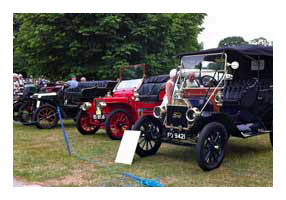 In 1972 York branch was approached by Newby Hall to organise a car rally in the grounds in July.(Just happens to fall on the writer’s birthday this year!).
This was a fairly new idea in the early 1970s, as formal rallies as we now know them did not exist. Individual car club members would just meet up at, usually, a pub or similar venue, or go on a road run.
After two years, Newby Hall decided to take over the running of the rally themselves. They mistakenly thought they would make more money if they did.
In 1976 York Branch was approached by Newby Hall to take over the running of the rally, as Harry Johnson and Sue Chalcroft were already heavily involved in the running of Sledmere, which took place two weeks before Newby. They declined. Bishop Auckland Branch took it on and still run it.
Initially organised by Stuart Skilbeck, who, for many years did the commentary, as he did with a roving microphone at Sledmere, then run for more than 28 years by Stuart and Kathleen Mcdonald, previously by Keith and Eric Dobinson, later by Colin Trotter and currently by Harry and Carol Fletcher.
The rally weekend is largely a Sunday affair with around 1700 vehicles attending, dating from 1898 to 1999 with all makes, including cars and commercials. Attendees are greeted at the rear entrance to the rally by marshals, Keith and Eric Dobinson. Judging was discontinued following the revival of the rally post pandemic in 2022.
In 1972 York branch was approached by Newby Hall to organise a car rally in the grounds in July.(Just happens to fall on the writer’s birthday this year!).
This was a fairly new idea in the early 1970s, as formal rallies as we now know them did not exist. Individual car club members would just meet up at, usually, a pub or similar venue, or go on a road run.
After two years, Newby Hall decided to take over the running of the rally themselves. They mistakenly thought they would make more money if they did.
In 1976 York Branch was approached by Newby Hall to take over the running of the rally, as Harry Johnson and Sue Chalcroft were already heavily involved in the running of Sledmere, which took place two weeks before Newby. They declined. Bishop Auckland Branch took it on and still run it.
Initially organised by Stuart Skilbeck, who, for many years did the commentary, as he did with a roving microphone at Sledmere, then run for more than 28 years by Stuart and Kathleen Mcdonald, previously by Keith and Eric Dobinson, later by Colin Trotter and currently by Harry and Carol Fletcher.
The rally weekend is largely a Sunday affair with around 1700 vehicles attending, dating from 1898 to 1999 with all makes, including cars and commercials. Attendees are greeted at the rear entrance to the rally by marshals, Keith and Eric Dobinson. Judging was discontinued following the revival of the rally post pandemic in 2022.
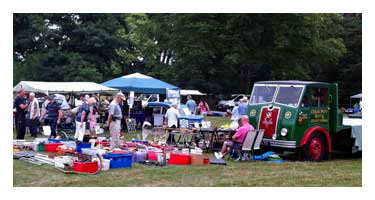 Areas can be allocated to one make clubs on request, e.g. Alvis, Austin A30 / 35 Club, Jaguar, and so on. In 2019, following regret expressed by some members that entries were limited to vehicles pre-1980, with a special class introduced for ‘Future Classics’. The limitations were age limits of 1984–1999, NECPWA members only, and a limited number of entries, booked on a first come, first served basis.
A large Auto jumble being a very popular attraction, was included, catering both for the enthusiast and the visitor, with traditional stalls, like John Firth’s offering “proper” auto jumble, mostly 1930s and earlier, Frank Headon with brake parts, Tony Pugh selling clutches and brake shoes and Dave Bond with the traditional mix of parts, keys and bulbs. Alongside these are tool stalls, plant stalls, motorcycle stalls, and dealers with displays of modern and historic vehicles. The atmosphere is added to by the well-informed commentary from Richard Lee.
The rally becomes ever more popular and is the largest car rally in the North of England.
Areas can be allocated to one make clubs on request, e.g. Alvis, Austin A30 / 35 Club, Jaguar, and so on. In 2019, following regret expressed by some members that entries were limited to vehicles pre-1980, with a special class introduced for ‘Future Classics’. The limitations were age limits of 1984–1999, NECPWA members only, and a limited number of entries, booked on a first come, first served basis.
A large Auto jumble being a very popular attraction, was included, catering both for the enthusiast and the visitor, with traditional stalls, like John Firth’s offering “proper” auto jumble, mostly 1930s and earlier, Frank Headon with brake parts, Tony Pugh selling clutches and brake shoes and Dave Bond with the traditional mix of parts, keys and bulbs. Alongside these are tool stalls, plant stalls, motorcycle stalls, and dealers with displays of modern and historic vehicles. The atmosphere is added to by the well-informed commentary from Richard Lee.
The rally becomes ever more popular and is the largest car rally in the North of England.
Other Rallies, Auto Jumbles
Rallies, as we now know them, did not exist in the 1960s, or previously. Club members, or groups of enthusiasts would merely meet up and set off, with the intention of stopping somewhere, maybe for a picnic or, most probably at a pub, or the coast. The first organised rally proper was held in 1967, the Skelton Brotton rally near Saltburn. This caught on, and more organised rallies by NECPWA and other clubs followed. Tony, will his irrepressible enthusiasm, spurred on other members to get involved in organising events. Malcolm Parker’s coast-to-coast run, Dave Bond’s Cars in the Park, are still going strong. Further south, John Firth, for many years, ran an auto jumble in February at the Riley Smith Hall, Tadcaster. It later moved to York Racecourse, later again to the Livestock Centre, Murton, York, eventually to be taken over by the Livestock Centre directly. Keith Dobinson’s Christmas Auction at Heighington was very popular, and it was a shame it ended. Tony’s fame spread, and if it wasn’t for him, events like Beamish would never have happened.
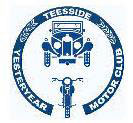 In 1966, Charles Davey approached Tony to set up a Teeside branch. Tony was busy getting Newcastle off the ground, but Charles decided to encourage Tony to help set up a car club anyway. This he did, and it is now known as the Teeside Yesteryear Car Club.
The first meeting was held at The Fisherman’s Cottage, Whitby. Mike Robinson took on the task of setting it up, later to be taken on by Charles Davey as Chairman. Thanks to Tony, both clubs have always been closely linked.
Beamish
The Beamish Museum was opened in 1970 by Dr Frank Atkinson; the hall and museum are located near the town of Stanley, Co. Durham.
In 1966, Charles Davey approached Tony to set up a Teeside branch. Tony was busy getting Newcastle off the ground, but Charles decided to encourage Tony to help set up a car club anyway. This he did, and it is now known as the Teeside Yesteryear Car Club.
The first meeting was held at The Fisherman’s Cottage, Whitby. Mike Robinson took on the task of setting it up, later to be taken on by Charles Davey as Chairman. Thanks to Tony, both clubs have always been closely linked.
Beamish
The Beamish Museum was opened in 1970 by Dr Frank Atkinson; the hall and museum are located near the town of Stanley, Co. Durham.
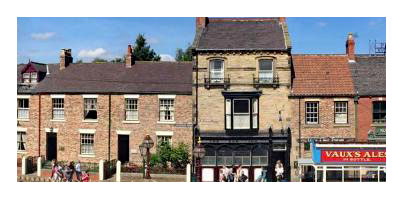 After visiting a Scandinavian folk museum in the late 1960s, Dr Atkinson realised, with the disappearance of coal mining, steel works and ship building and along with it its people, much of the north-east heritage could disappear. Frank, the then director of Bowes museum, Barnard Castle, presented a report to Durham CC, recommending “every day” items be collected to form an “open air” museum.
Beamish was opened in 1970 and has grown to include shops, a dentist, school, pit village and trams (with a 1950s village now being constructed).
Dr. Atkinson had heard of NECPWA and being forward-thinking, invited NECPWA to provide a Classic Car Rally, and even chose the date, which still stands. Initially run by Stewart Skilbeck, later by Derek Cansfield for many years, it has grown in popularity and is much enjoyed today.
After visiting a Scandinavian folk museum in the late 1960s, Dr Atkinson realised, with the disappearance of coal mining, steel works and ship building and along with it its people, much of the north-east heritage could disappear. Frank, the then director of Bowes museum, Barnard Castle, presented a report to Durham CC, recommending “every day” items be collected to form an “open air” museum.
Beamish was opened in 1970 and has grown to include shops, a dentist, school, pit village and trams (with a 1950s village now being constructed).
Dr. Atkinson had heard of NECPWA and being forward-thinking, invited NECPWA to provide a Classic Car Rally, and even chose the date, which still stands. Initially run by Stewart Skilbeck, later by Derek Cansfield for many years, it has grown in popularity and is much enjoyed today.
Club Stores
Upon starting the club, Tony decided it would be a good idea to collect old cars and parts, mainly Austins, to save them from the scrap man. On behalf of the club, he rented Three Mile Garage on The Great North Road at Gosforth, north of Newcastle. It was an old blacksmiths shop at a peppercorn rent, and he would haul in spares from all over the North East. Garages and the like were keen to donate obsolete parts, hence the beginning of the club stores. When the owner died, it was put up for sale at a price the club could not afford. A move to Beamish Open Air Museum was considered and ultimately, a club “Vintage Garage”, but was rejected as too costly, as Beamish could not offer any financial support and the cost of building suitable premises would be in the region of £1,000. Temporary accommodation, in the form of containers, was considered, but the cost of buying these would be around £500 per container. Shildon looked the better option. In July 1980, the stores were moved to a former ice cream factory in Shildon.
In those days, the club produced a news-sheet. This included dates of forthcoming events, general chit-chat and sales of spares and cars, composed by Tony and reproduced on a Gestetner. Tony had asked Stuart and Kathleen Macdonald, who had joined the club two years before, if they were interested in having a talk at his home to discuss a meeting of Bishop Auckland Branch. Stuart was puzzled, as there was already a meeting in the area. When Stuart joined the club, he “kept a low profile”. This would not do for Tony, who roped everyone in, whether they wanted to be, or not. Upon arrival at Tony’s house, they were immediately involved in the packing of the News Sheet, writing the envelopes by hand and 47 years on, they are still doing it! [Assistance now from the Cooks and technology in the form of sticky labels from the Membership Dept!]
On 13 January 1985, it was decided to hold an emergency Executive Committee Meeting as Stuart MacDonald informed the committee of the proposed “change of use” to the stores at Ferryhill was unsuccessful, and they once again had to move. Our permanent premises at West Cornforth were purchased in March 1985, largely paid for by donations from members. A 20% deposit was paid to the owner to secure the purchase. There was an urgency, as the building at Ferryhill Station had to be vacated, and this was instrumental in the decision to find a permanent premises owned by the club. Opening times and contact information are advertised each month in NECPWA News
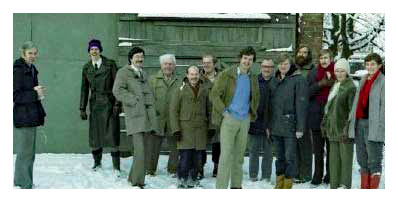 It’s 30 years since we took over the present Stores building at West Cornforth. I have found a photo taken in January 1985 when an “Inspection Party” visited to see if the building was suitable. We didn’t pick the best of days with a few inches of snow lying on the ground, but following that visit, we agreed to go ahead with the purchase.
The club stores continue to provide valuable parts and information to its members, sells discounted new tyres and, in Tony’s tradition, sources parts. Opening times and contact information are
Photo by Ian Findlay. Some members meet outside the stores: L to R: Charles Davey, Keith Dobinson, Nigel Holmes, Graham Austin, Joe Gardner (one-time Chairman), Janek Grajewski, Stuart Macdonald, Dave Bond, Gordon Tildesley (Treasurer at the time), John Allaker, Harry Johnson, Dave Schofield, Kathleen MacDonald and Gillian Findlay.
It’s 30 years since we took over the present Stores building at West Cornforth. I have found a photo taken in January 1985 when an “Inspection Party” visited to see if the building was suitable. We didn’t pick the best of days with a few inches of snow lying on the ground, but following that visit, we agreed to go ahead with the purchase.
The club stores continue to provide valuable parts and information to its members, sells discounted new tyres and, in Tony’s tradition, sources parts. Opening times and contact information are
Photo by Ian Findlay. Some members meet outside the stores: L to R: Charles Davey, Keith Dobinson, Nigel Holmes, Graham Austin, Joe Gardner (one-time Chairman), Janek Grajewski, Stuart Macdonald, Dave Bond, Gordon Tildesley (Treasurer at the time), John Allaker, Harry Johnson, Dave Schofield, Kathleen MacDonald and Gillian Findlay.
Name Change
The fledgling club had no name until brothers Mike and Roger Potts in early 1967 suggested that, as we cater for Austins and we are based in the north-east, we should call ourselves “The North East Club for Pre-War Austins”. This name was taken up and stood for many years, and was generally known as “NECPWA”, even getting a write-up in the 1980s by Practical Classics magazine as being the most informative and informal, but dedicated, car club. My good friend, the often prickly Bill Abbott, said that what drew him to the club was “its bumbling informality, but which always got there”. How right he was, and with no need to change. However, change was on the horizon in the form of George Dalgarno, who argued, that the Club name was getting out of date and did not represent current or future members. At the AGM on 28th April 2012 at New Hartley, 45% of those present voted for a name change. Various names were suggested: the late Don Child, one time chairman, tongue in cheek, suggested “The Nearly Everywhere Club for Pretty Well Anything”. This was not taken up, despite a lot of disagreement within the club at the time! Suggestions for a new name were put to a vote, and Trevor Lund’s suggestion was carried. It is now known as “North of England Classic and Pre-War Automobiles”. An original fear was that members would leave, and, indeed, some did, but the decision was ultimately shown to be right, as membership has since gone up by approximately 30%.
The Future, including Chairman’s Comments.
There are a number of reasons why we are attracted to older vehicles, whether they are bikes, cars, fire engines, stationary engines, etc. - usually it’s nostalgia. The current trend for 1980 and 1990 Fords bears this out. Former Chairman, Harry Johnson bought his Rover BRH 80 in 1972 and rebuilt it in a week. I remember him telling me he had just got the chassis stove enamelled and was going to start putting it back together - it was 9.00 pm! His first rally was at Roundhay Park, Leeds, where he met Stan Whinham, who invited him to Newby Hall. Sadly, it was the last rally there. I mention Harry, for it was his enthusiasm I became involved in NECPWA; like Stuart Macdonald, I was happy to stay on the side-line. Over the last 50 years, NECPWA has had many Chairmen: Tony Pelton, Joe Gardner, Stewart Skilbeck, Ian Finlay, Harry Johnson, Derek Cansfield, John Schumacher and latterley, John Bilton. Some are no longer with us, hence my history articles.
Conclusion
In Feb. 1987, our 21st year anniversary, we produced a Birthday Souvenir. The last paragraph offers resolutions for the future, these are as follows: • Send in articles for the newsletter; anything will do, technical, quizzes, stories. • Help the stores expand and improve. • Use the club Library, it’s free! • Attend as many rallies as you can. • Suffer branch meetings, and tell them what YOU want to happen - you may enjoy them. • Support the Executive Committee. • Help the club officials. I wonder how much of the above has been fulfilled, as this still holds good today. Though club officials change, it’s you the members who continue the success of the club which is still operating strongly, despite all that 'Covid' threw at us in 2020/2021. Thanks to all who have contributed to producing these articles.
© Janek Grajewski, Club Librarian & Archivist.